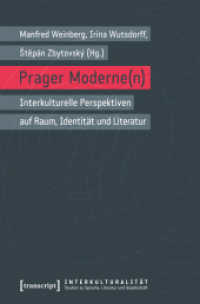- ホーム
- > 洋書
- > 英文書
- > Science / Mathematics
Full Description
Lasers are employed throughout science and technology, in fundamental research in chemistry, physics and engineering, the remote sensing and analysis of atmospheric gases or pollutants, communications, medical diagnostics and therapies, and in various forms of manufacturing, including microelectronic devices. Understanding the principles of the operation of lasers which underlies all of these areas is essential for a modern scientific education.
Building on the first edition, Laser Experiments for Chemistry and Physics Second Edition includes experiments with new and improved methods and instrumentation. It explores the characteristics and operation of lasers through laboratory experiments designed for the undergraduate curricula in chemistry and physics. Introductory chapters describe the properties of light, the history of laser invention, the atomic, molecular, and optical principles behind how lasers work and the most important kinds of lasers available today. Other chapters include the basic theory of spectroscopy and computational chemistry used to interpret laser experiments and the applications of lasers in spectroscopy and photochemistry. Experiments range from simple in-class demonstrations to more elaborate configurations for advanced students. Each chapter has historical and theoretical background, as well as options suggested for variations on the prescribed experiments.
This text will be useful for undergraduate students in advanced lab classes, for instructors designing these classes, or for graduate students beginning a career in laser science. It can also be used as a supplementary text for courses in molecular spectroscopy or optics.
Contents
1: Elementary Properties of Light
2: Basic Optics
3: General Characteristics of Lasers
4: Laboratory Lasers
5: Nonlinear Optics
6: Laser Safety
7: The Speed of Light
8: The Speed of Sound in Gases, Liquids, and Solids
9: Thermal Lens Calorimetry
10: Laser Refractometry
11: Laser-Induced Breakdown Spectroscopy
12: Laser Desorption Time-of-Flight Mass Spectrometry
13: Multiphoton Ionization Mass Spectrometry of Metal Carbonyls
14: Optical Spectroscopy
15: Quantum Chemistry Calculations
16: Multiphoton Ionization and Third Harmonic Generation in Alkali Atoms
17: Electronic Absorption Spectroscopy of Molecular Iodine
18: Electronic Spectroscopy of Iodine Using REMPI
19: Raman Spectroscopy Under Liquid Nitrogen
20: Raman Spectroscopy of Carbon Nanomaterials
21: Optical Rotary Dispersion of a Chiral Liquid (a-pinene)
22: Faraday Rotation
23: Fermi Resonance in CO2
24: Photoacoustic Spectroscopy of Methane
25: Optogalvanic Spectroscopy
26: Diode Laser Atomic Spectroscopy
27: Raman Shifting and Stimulated Electronic Raman Scattering (SERS)
28: Fluorescence Lifetime of Iodine Vapor
29: Semiconductor Quantum Dots
30: Raman Spectroscopy Applied to Molecular Conformational Analysis
31: Diffraction of Light from Blood Cells
32: Laser Induced Crystal Growth







